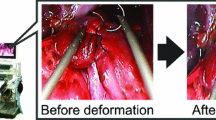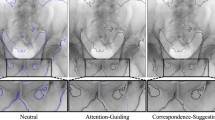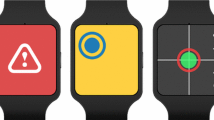Abstract
Background
In the field of minimally invasive surgery, specifically in pathway surgery (i.e. minimal invasive procedures carried out transluminally or through instrument-created pathways), spatial disorientation is a common experience to endoscopists. In this article, two effects that may cause spatial disorientation in pathway surgery, ‘control-display compatibility’ and ‘local disorientation’, were studied.
Method
A custom-developed simulator Endo-PaC was developed and used for mimicking pathway surgical scenarios. In Study 1, two ways of control-display alignment, normal mapping and mirrored mapping, were tested in combination with two control devices, thumb control and wrist control, in an orienting task using Endo-PaC. In Study 2, a tethered viewpoint was added to the virtual instrument tip. It was hypothesized that the visible tip would provide a cue of orientating direction in the reference frame during the instrument navigation. In both studies, novice participants were involved, and their performance was evaluated with regard to task time, path length travelled by the virtual tip, time and number of warnings, and subjective workload and personal preference.
Results
In Study 1, normal-thumb and normal-wrist mapping yielded significantly lower means than mirrored-thumb and mirrored-wrist control for all investigated objective and subjective performance measurements. Out of 24 participants, 20 participants preferred normal control mapping. In Study 2, participants performed the task in shorter time and with shorter path length when the tip was visible tip on the monitor using a tethered viewpoint, but with a lower number and time of warnings without a visible tip.
Conclusion
The results of our studies show that eliminating the visual-display misalignment would greatly improve novice participants’ performance, reduce the training time and their cognitive workload. A visible tip on the monitor would provide strong direction cue and shorten the performance time, but might introduce collision errors to novices and therefore requires longer training time.










Similar content being viewed by others
References
Rattner D, Kalloo A (2006) ASGE/SAGES ASGE/SAGES working group on natural orifice translumenal endoscopic surgery. Surg Endosc 20(2):329–333
Shahinian HK, Kabil MS, Jarrahy R (2008) Endoscopic skull base surgery: a comprehensive guide with illustrative cases. Humana Press, Totowa
Cao CG, Milgram P (2000) Disorientation in minimal access surgery: a case study. In: Proceedings of the Human Factors and Ergonomics Society Annual Meeting, SAGE Publications, pp 169–172
Worringham CJ, Beringer DB (1989) Operator orientation and compatibility in visual-motor task performance. Ergonomics 32(4):387–399
Chan WH, Chan AHS (2007) Strength and reversibility of movement stereotypes for lever control and circular display. Int J Ind Ergon 37(3):233–244
Hollands JG, Wickens CD (1999) Engineering psychology and human performance. Prentice Hall, Upper Saddle River
Smith RL, Stuart MA (1989) The effects of spatially displaced visual feedback on remote manipulator performance. In: Proceedings of the Human Factors and Ergonomics Society Annual Meeting, SAGE Publications, pp 1430–1434
Brooks TL, Ince I (1992) Operator vision aids for telerobotic assembly and servicing in space. In: Proceedings of the IEEE International Conference on Robotics and Automation, pp 886–891
Gray SV, Wilson JR, Syan CS (1992) Human control of robot motion: orientation, perception and compatibility. In: Human-robot interaction. Taylor & Francis, London, pp 48–64
Macedo JA, Kaber DB, Endsley MR, Powanusorn P, Myung S (1998) The effect of automated compensation for incongruent axes on teleoperator performance. J Hum Factors Ergon Soc 40:541–553
McKee GT, Schenker PS (1993) Nonanthropomorphic viewing for teleoperation. In: Optical tools for manufacturing and advanced automation. International Society for Optics and Photonics, pp 282–291
Gallagher AG, McClure N, McGuigan J, Ritchie K, Sheehy NP (1998) An ergonomic analysis of the fulcrum effect in the acquisition of endoscopic skills. Endoscopy 30:617–620
Hills JW, Green PS, Jensen JF, Gorfu Y, Shah AS (1994) Telepresence surgery demonstration system. In: Proceedings of the IEEE International Conference on Robotics and Automation, pp 2302–2307
Fan C, Dodou D, Breedveld P (2012) Review of manual control methods for handheld manoeuvrable instruments. Minim Invasive Ther Allied Technol 22:127–135
Hart SG, Staveland LE (1988) Development of NASA-TLX (Task Load Index): results of empirical and theoretical research. Hum Ment Workload 1:139–183
De Winter JCF (2014) Controversy in human factors constructs and the explosive use of the NASA TLX: a measurement perspective. Cogn Technol Work 16:289–297
Breedveld P (2010) Steerable laparoscopic cable-ring forceps. J Med Devices 4(2):027518-1
Wickens CD, Vincow M, Yeh M (2005) Design application of visual spatial thinking: the importance of frame of reference. In: Shah P, Miyake A (eds) The Cambridge handbook of visuospatial thinking, Cambridge University Press, pp 383–425
Winckens CD, Hollands JG, Parasuraman R, Banbury S (2012) Engineering psychology and human performance, 4th edn. Pearson, Boston
McCormick EP, Wickens CD, Banks R, Yeh M (1998) Frame of reference effects on scientific visualization subtasks. J Hum Factors Ergon Soc 40(3):443–451
Wang W, Milgram P (2001) Dynamic viewpoint tethering for navigation in large-scale virtual environments. In: Proceedings of the Human Factors and Ergonomics Society Annual Meeting, SAGE Publications, pp 1862–1866
Wang W, Milgram P (2003) Effects of viewpoint displacement on navigational performance in virtual environments. In: Proceedings of the Human Factors and Ergonomics Society Annual Meeting, SAGE Publications, pp 139–143
Golledge RG (1999) Human wayfinding and cognitive maps. In: Golledge RG (ed) Wayfinding behaviour: cognitive mapping and other spatial processes, Johns Hopkins Press, Baltimore, pp 5–45
Cotton PB, Williams CB (2008) Practical gastrointestinal endoscopy: the fundamentals. Wiley, Blackwell
Cirocco WC, Rusin LC (1996) Fluoroscopy, a valuable ally during difficult colonoscopy. Surg Endosc 10(11):1080–1084
Cao CGL (2001) Designing for spatial orientation in endoscopic environments. In: Proceedings of the Human Factors and Ergonomics Society Annual Meeting, SAGE Publications, pp 1259–1263
Marvik RM, Langø T, Tangen GA, Andersen JO, Kaspersen JH, Ystgaard B et al (2004) Laparoscopic navigation pointer for three-dimensional image-guided surgery. Surg Endosc Other Interv Tech 18(8):1242–1248
Saunders BP, Bell GD, Williams CB, Bladen JS, Anderson AP (1995) First clinical results with a real time, electronic imager as an aid to colonoscopy. Gut 36(6):913–917
Taylor HA, Brunye TT, Taylor ST (2008) Spatial mental representation: implications for navigation system design. Rev Hum Factors Ergon 4(1):1–40
Haluck RS, Webster RW, Snyder AJ, Melkonian MG, Mohler BJ, Dise ML, Lefever A (2003) A virtual reality surgical trainer for navigation in laparoscopic surgery. Med Meets Virtual Real 105(2):119–131
Carrozza MC, Arena A, Accoto D, Menciassi A, Dario P (2003) A SMA-actuated miniature pressure regulator for a miniature robot for colonoscopy. Sens Actuators A 105(2):119–131
Ng WS, Phee S, Seow C, Davies BL (2000) Development of a robotic colonoscope. Dig Endosc 12(2):131–135
Zazzarini CC, Pansini A, Cerveri P, Zaltieri R, Lavizzari D (2011) Design of a robotic endoscope for mini invasive surgery. In: ASME 2011 International Design Engineering Technical Conferences and Computers and Information in Engineering Conference. American Society of Mechanical Engineers, pp 771–777
Inoue H, Okabe S, Takeshita K, Muraoka Y, Yoneshima H, Endo M (1993) Colonoscopy using a transparent plastic cap. Gastroenterol Endosc 35:378–381
Tsumura T, Torii A, Fujita S, Takeda J, Hikita H, Nishikawa H, Ochi J, Miura K (2003) Usefulness of oblique transparent cylinders in facilitating colonoscopy. Dig Endosc 15(2):121–124
Dafnis GM (2000) Technical considerations and patient comfort in total colonoscopy with and without a transparent cap: initial experiences from a pilot study. Endoscopy 32(5):381–384
Kondo S, Yamaji Y, Watabe H, Yamada A, Sugimoto T, Ohta M et al (2007) A randomized controlled trial evaluating the usefulness of a transparent hood attached to the tip of the colonoscope. Am J Gastroenterol 102(1):75–81
Yap CK, Ng HS (2001) Cap-fitted gastroscopy improves visualization and targeting of lesions. Gastrointest Endosc 53(1):93–95
Urita Y, Nishino M, Ariki H, Ozaki M, Naruki Y, Otsuka S (1997) A transparent hood simplifies magnifying observation of the colonic mucosa by colonoscopy. Gastrointest Endosc 46(2):170–172
Lee YT, Hui AJ, Wong VWS, Hung LCT, Sung JJY (2006) Improved colonoscopy success rate with a distally attached mucosectomy cap. Endoscopy 38(7):739–742
Tada M, Inoue H, Yabata E, Okabe S, Endo M (1997) Feasibility of the transparent cap-fitted colonoscope for screening and mucosal resection. Dis Colon Rectum 40(5):618–621
Matsushita M, Hajiro K, Okazaki K, Takakuwa H, Tominaga M (1998) Efficacy of total colonoscopy with a transparent cap in comparison with colonoscopy without the cap. Endoscopy 30(5):444–447
Harada Y, Hirasawa D, Fujita N, Noda Y, Kobayashi G, Kazuhiko I, Yonechi M et al (2009) Impact of a transparent hood on the performance of total colonoscopy: a randomized controlled trial. Gastrointest Endosc 69(3):637–644
Acknowledgments
The research was funded by the Marie Curie Initial Training Network project IIIOS (Integrated Interventional Imaging Operation System, Project 238802) and carried out at the department BioMechanical Engineering of Delft University of Technology. The authors want to thank all the participants as well as Filip Jelinek and David Jager for designing and manufacturing the Endo-PaC.
Disclosures
The authors Chunman Fan, Dimitra Dodou, Paul Breedveld and Jenny Dankelman have no conflicts of interest or financial ties to disclose.
Author information
Authors and Affiliations
Corresponding author
Rights and permissions
About this article
Cite this article
Fan, C., Dodou, D., Breedveld, P. et al. Spatial orientation in pathway surgery. Surg Endosc 29, 2705–2719 (2015). https://doi.org/10.1007/s00464-014-3993-9
Received:
Accepted:
Published:
Issue Date:
DOI: https://doi.org/10.1007/s00464-014-3993-9




